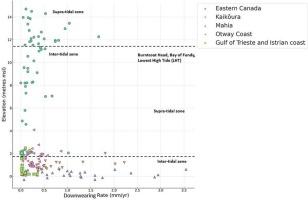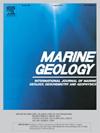Micro-Erosion Meter derived downwearing rates on inter-tidal shore platforms at Māhia Peninsula, New Zealand: Implications for uplifted rock coasts
IF 2.2
3区 地球科学
Q2 GEOSCIENCES, MULTIDISCIPLINARY
引用次数: 0
Abstract
Downwearing rates obtained from tectonically active coasts provide evidence of rapid rock breakdown following coseismic uplift. These measurements help solve puzzles about ‘missing' marine terraces and have implications for accurate reconstruction of past sea levels, earthquakes and rock coast evolution. However, very few detailed erosion datasets exist for uplifted shore platforms, making it uncertain if erosion records from one coast can be extrapolated to other regions with similar tectonic, geologic, or geomorphic characteristics. Here we present new downwearing rates from an inter-tidal mudstone shore platform at Kahutara Point, Māhia Peninsula, New Zealand that was uplifted likely by ∼3 m within the last 300 years. Downwearing rates were measured over 49 months/4.05 years using the Micro-Erosion Meter (MEM) and Structure-from-Motion photogrammetry: the mean annual downwearing rate was 1.08 mm yr−1, while the total erosion at individual MEM stations ranged from 0.44 to 14.37 mm (equivalent to mean downwearing rates of 0.11 to 3.54 mm yr−1). Orthophotographs of the eroded rock surfaces indicate the combined role of marine processes (waves and tides), sub-aerial weathering processes, salt weathering and biological activity in the erosion of the mudstone platform surface. The downwearing rates from Kahutara Point, Māhia Peninsula are statistically similar to previously published downwearing rates (1.23 mm yr−1) from mudstone platforms at Kaikōura Peninsula, New Zealand, that were obtained prior to the 2016 Kaikōura earthquake, but are significantly different from perturbed post-uplift downwearing rates (2.25 mm yr−1) obtained from the same MEM stations following coseismic uplift of ∼1 m. This work provides valuable data to support comparison of the development of shore platforms and marine terraces at Kaikōura and Māhia at different stages of their tectonic evolution.

微侵蚀仪在Māhia半岛潮汐间海岸平台上得出的下降速率,新西兰:对隆起的岩石海岸的影响
从构造活跃的海岸得到的下降速率提供了同震隆起后岩石快速破碎的证据。这些测量有助于解决关于“失踪”的海洋梯田的难题,并对精确重建过去的海平面、地震和岩石海岸演变具有重要意义。然而,对于隆起的海岸平台,很少有详细的侵蚀数据集,因此不确定一个海岸的侵蚀记录是否可以外推到具有类似构造、地质或地貌特征的其他地区。在这里,我们展示了新西兰Māhia半岛Kahutara Point的潮间带泥岩海岸平台的新下降速率,该平台在过去300年中可能上升了约3米。使用微侵蚀仪(MEM)和动态结构摄影测量法测量了49个月/4.05年的侵蚀率:平均年侵蚀率为1.08毫米/年,而各个MEM站点的总侵蚀率为0.44至14.37毫米(相当于平均侵蚀率为0.11至3.54毫米/年)。侵蚀岩石表面的正射影片显示了海洋作用(波浪和潮汐)、空中风化作用、盐风化作用和生物活动在泥岩台地表面侵蚀中的综合作用。Māhia半岛Kahutara Point的下降速率与之前公布的2016年Kaikōura地震前在新西兰Kaikōura半岛泥岩平台上获得的下降速率(1.23 mm yr - 1)在统计上相似,但与同一MEM台站在同震隆起~ 1 m后获得的扰动后下降速率(2.25 mm yr - 1)有显著差异。这项工作为比较Kaikōura和Māhia不同构造演化阶段的海岸台地和海相台地的发育提供了有价值的资料。
本文章由计算机程序翻译,如有差异,请以英文原文为准。
求助全文
约1分钟内获得全文
求助全文
来源期刊

Marine Geology
地学-地球科学综合
CiteScore
6.10
自引率
6.90%
发文量
175
审稿时长
21.9 weeks
期刊介绍:
Marine Geology is the premier international journal on marine geological processes in the broadest sense. We seek papers that are comprehensive, interdisciplinary and synthetic that will be lasting contributions to the field. Although most papers are based on regional studies, they must demonstrate new findings of international significance. We accept papers on subjects as diverse as seafloor hydrothermal systems, beach dynamics, early diagenesis, microbiological studies in sediments, palaeoclimate studies and geophysical studies of the seabed. We encourage papers that address emerging new fields, for example the influence of anthropogenic processes on coastal/marine geology and coastal/marine geoarchaeology. We insist that the papers are concerned with the marine realm and that they deal with geology: with rocks, sediments, and physical and chemical processes affecting them. Papers should address scientific hypotheses: highly descriptive data compilations or papers that deal only with marine management and risk assessment should be submitted to other journals. Papers on laboratory or modelling studies must demonstrate direct relevance to marine processes or deposits. The primary criteria for acceptance of papers is that the science is of high quality, novel, significant, and of broad international interest.
 求助内容:
求助内容: 应助结果提醒方式:
应助结果提醒方式:


